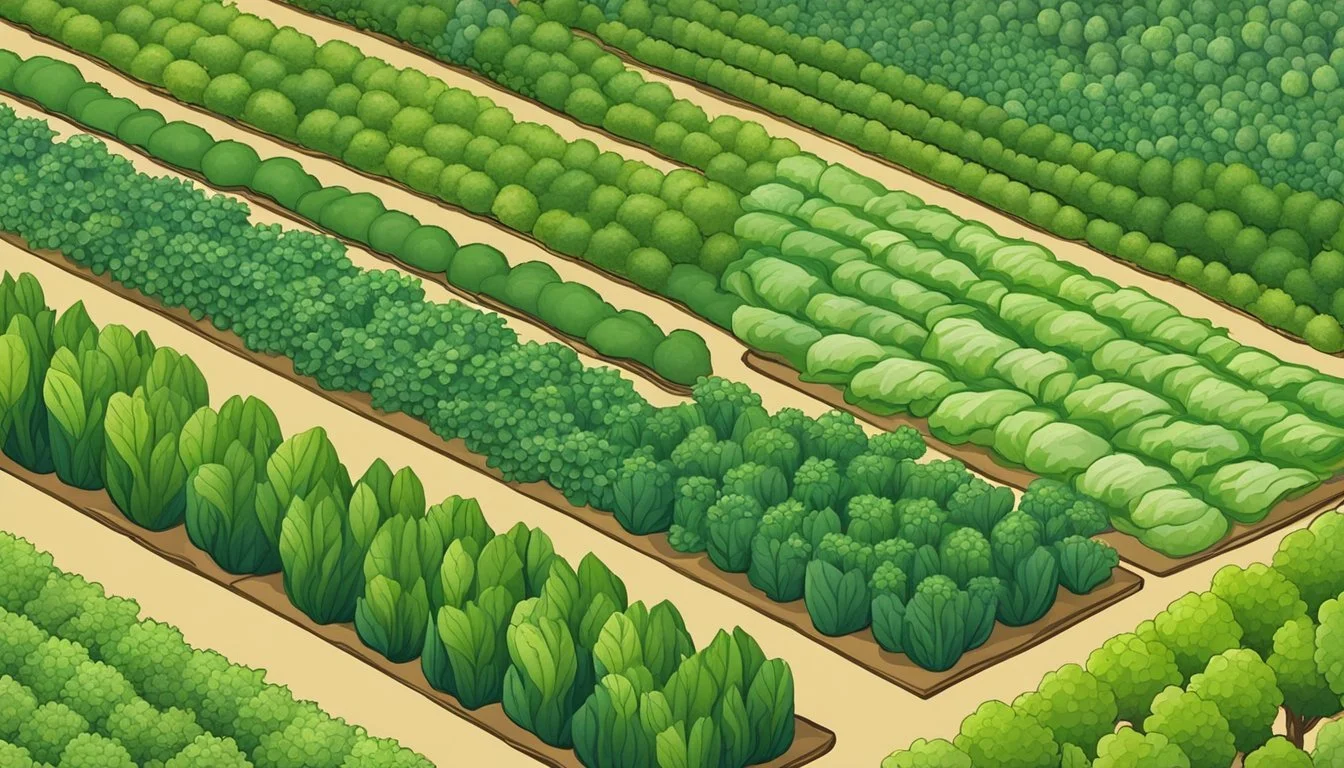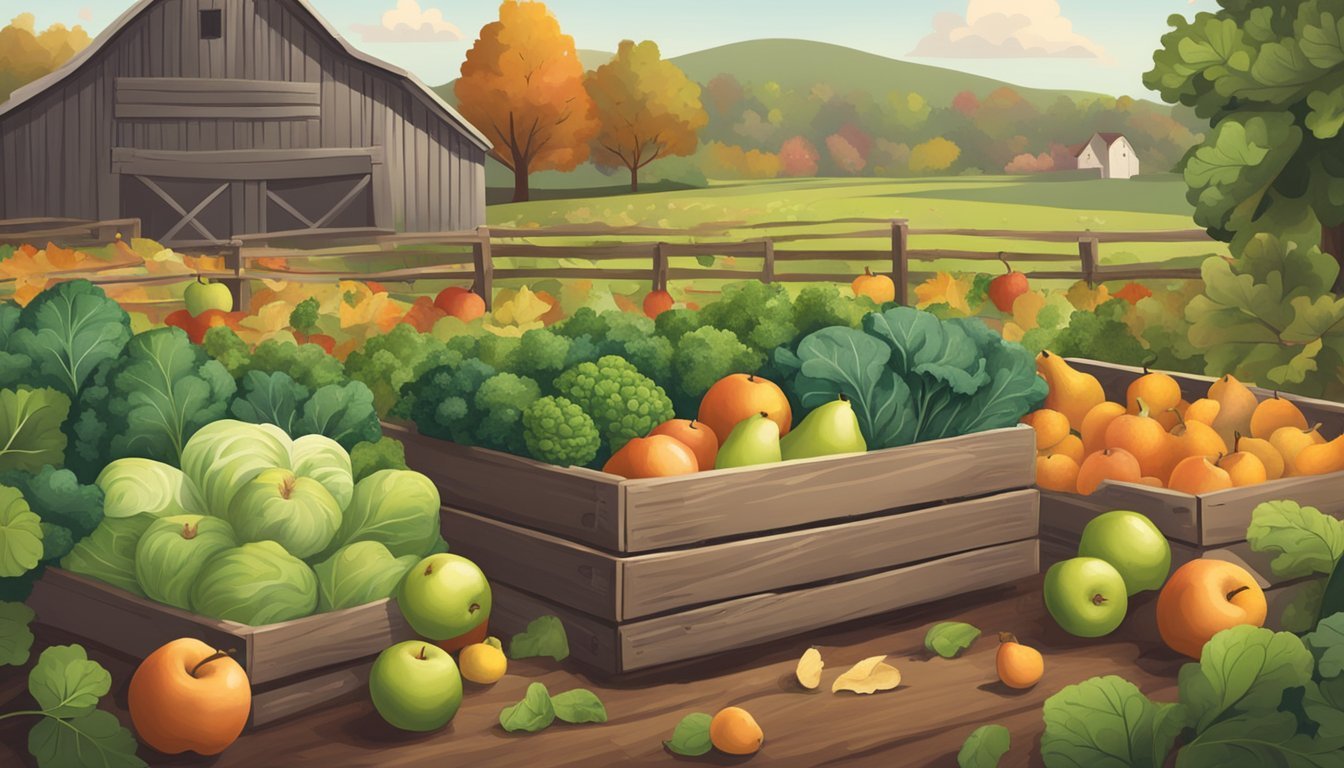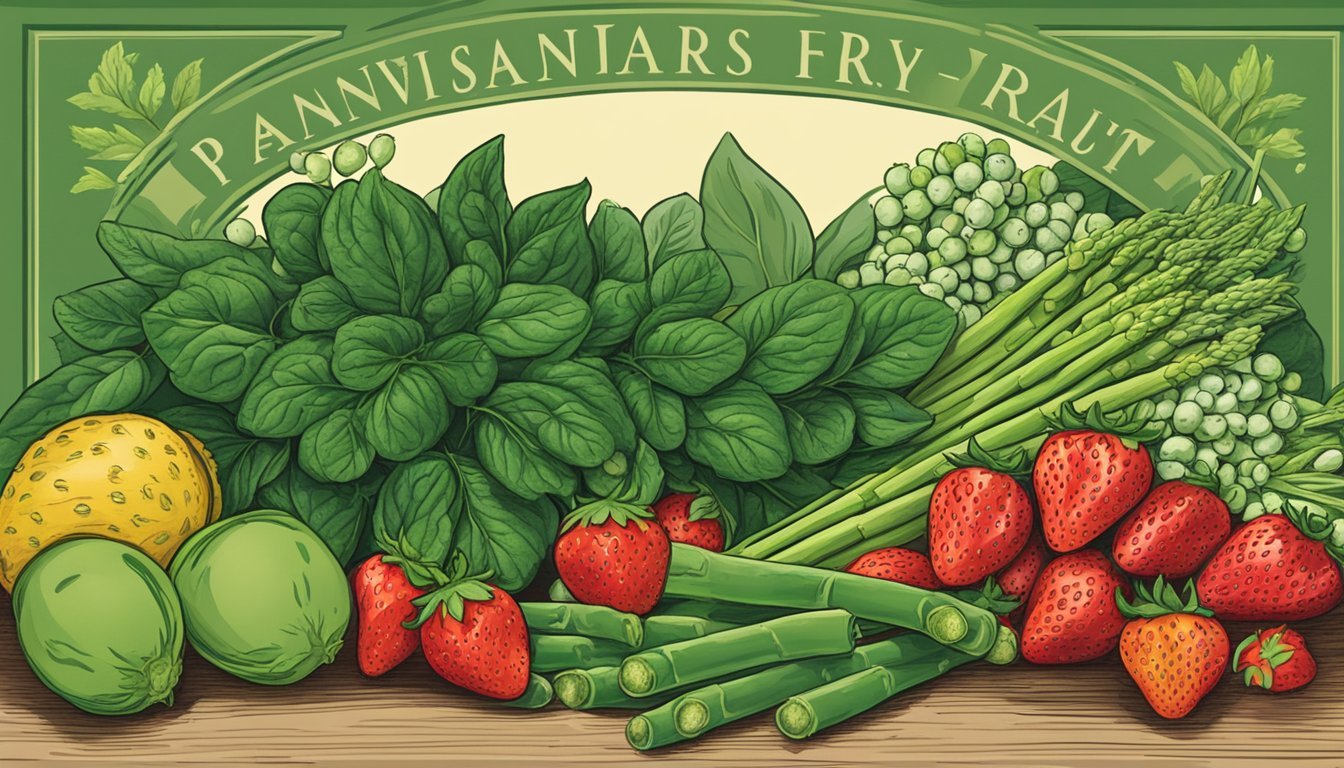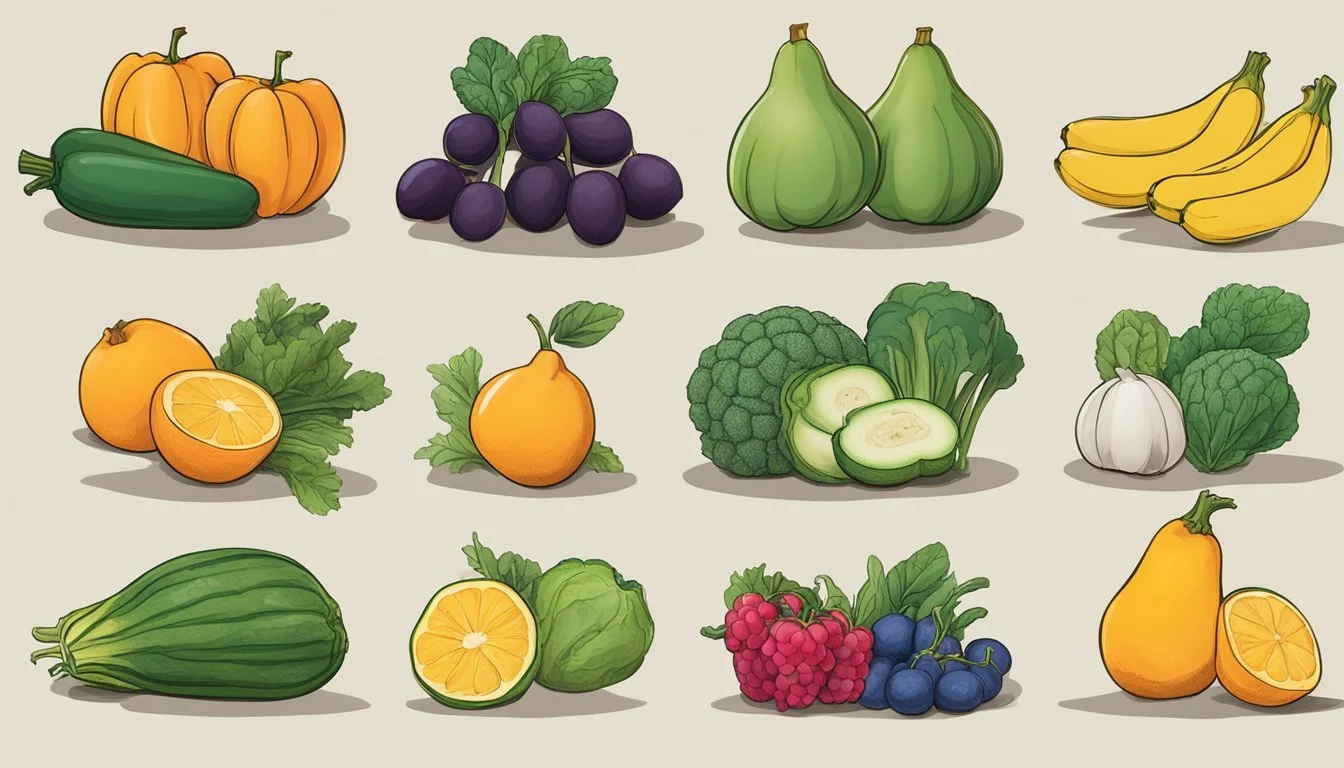Pennsylvania Seasonal Fruit & Vegetables in March
Your Ultimate Guide
This Article is Part of our Pennsylvania Seasonal Fruit & Veg Calendar
In Pennsylvania, March marks the transitional period between the remnants of winter's final chill and the onset of spring's warmth. While the selection of produce is still reflective of the hearty vegetables that thrive in cooler temperatures, the impending switch to spring introduces the beginning of a more varied and colorful harvest. Local markets begin to showcase the last of winter's bounty alongside the early signs of spring produce.
As far as fruits go, options are understandably limited during this time since most fruit crops require the warmer days ahead to ripen. However, this doesn't leave Pennsylvania's produce palette lacking. Root vegetables and storage crops—such as potatoes, onions, and apples from the previous year's harvest—remain available due to their longer shelf life.
Seasonality is at the heart of Pennsylvania produce in March, emphasizing the importance of supporting local farmers and enjoying fruits and vegetables at their most flavorful. Consumers can expect the availability of late-winter vegetables like cabbages and carrots (how long do carrots last?), which often can be stored well into the transition months. Meanwhile, some greenhouses might offer a head start on greens such as lettuce and spinach (What wine goes well with spinach?), hinting at the diversity to come with spring.
Overview of Pennsylvania's Seasonal Produce
Pennsylvania offers a rich tapestry of seasonal produce, ensuring that a variety of fresh and nutritious fruits and vegetables are available throughout the year. One can find delicious, locally grown options that align with both personal health goals and support for the local agriculture.
Benefits of Eating Seasonal Produce
Eating seasonally in Pennsylvania means enjoying fruits and vegetables at their peak of freshness and nutritional value. When produce is eaten close to its harvest date, it is often more flavorful and richer in antioxidants and nutrients. Furthermore, seasonal eating can support local farmers and reduce environmental impact associated with long-distance transportation.
Understanding Pennsylvania's Growing Seasons
Pennsylvania has distinct growing seasons, with varying climates and temperatures affecting the produce that is available. In March, for instance, while some fruits and vegetables from the fall and winter seasons, such as apples and carrots, may still be available from storage, the options for freshly harvested produce are more limited. However, this does not detract from the enjoyment of the following seasonal offerings:
Apples: Stored from the fall but still crisp and delicious.
Carrots: Overwintered and available from storage, providing a sweet and crunchy addition to meals.
Root Vegetables: Such as beets and turnips, usually still available in good condition from storage.
Greens: Certain hearty greens like kale may persist or be available from greenhouses.
As the state moves towards spring, the selection will expand, with more fresh options becoming available. Consumers should look forward to the emergence of spring vegetables like asparagus (how long does asparagus last?) and rhubarb in the coming months.
March's Seasonal Fruits in Pennsylvania
In Pennsylvania, March is a transitional month for agriculture, but consumers can still enjoy the waning bounty of winter fruits. Apples and pears remain available, providing freshness and Vitamin C to the diet.
Apples in Late Winter
Late winter apples in Pennsylvania are typically those that store well and maintain their quality post-harvest. Consumers will find varieties like Fuji, which retains its crispness and sweet flavor, and Pink Lady, known for its balance of sweet and tart. These apples are not only fresh but also rich in Vitamin C, making them an ideal choice for nutritious snacking or cooking as the season transitions from winter to spring.
Fuji: Crisp, sweet, available in storage
Pink Lady: Sweet-tart, retains freshness
Pears Variety and Selection
As for pears, several varieties are still on the shelves in March, notable for their soft, buttery texture and subtly sweet flavor. Bartlett pears are commonly found, which are excellent for both eating fresh and for culinary uses like baking. When selecting pears, shoppers should look for ones that are firm to the touch with a slight give, indicating they are ripe and ready to eat.
Bartlett Pears: Soft texture, subtly sweet, versatile for fresh eating and cooking
For those exploring local markets or grocery stores, these fruits offer a continued taste of Pennsylvania's seasonal harvest even in early spring.
Seasonal Vegetables to Enjoy in March
March in Pennsylvania ushers in a transition period for produce, where winter favorites are still available, and early spring vegetables begin to make their appearance. This is an optimal time to indulge in a range of nutrient-rich, flavorful vegetables.
Cruciferous Vegetables Peak Season
Cauliflower and broccoli (how long does broccoli last?)thrive during early spring in Pennsylvania. These cruciferous vegetables are at their peak, promising the best in flavor and nutritional value. Rich in vitamins C and K, as well as fiber, they can be enjoyed both raw and cooked in various dishes.
Cabbage is another cruciferous vegetable that remains in season during March. It's versatile and can be used in salads, stews, or as the main ingredient in traditional dishes like sauerkraut (how long does sauerkraut last?).
Leafy Greens Flourish in Early Spring
With the onset of spring, spinach emerges as a star leafy green. Its tender leaves are perfect for salads and are a great source of iron and magnesium.
Here's what one can find in this category during March:
Leafy Greens Availability Spinach Early Spring
Root Vegetables Still in Season
Root vegetables linger from the colder months, carrying over the earthy flavors (What wine goes well with earthy flavors?) of winter. They are hearty and form a substantial part of meals during this period.
Vegetable varieties such as carrots and beets, for example, continue to be available. These can be roasted to bring out their natural sweetness or incorporated into soups for added depth of flavor.
Herbs and Flavors of March
In March, Pennsylvania's herb gardens begin to offer fresh flavors that are essential for springtime cooking. Aromatic herbs like parsley and thyme start becoming more available and can significantly enhance the taste profiles of seasonal dishes.
Aromatic Herbs for March Cooking
Parsley and thyme are two of the most versatile herbs that come into season in March. They are both known for their fresh, pungent aromas and the ability to complement a wide variety of dishes.
Parsley:
Italian Flat Leaf: Known for its bright, slightly peppery taste.
Curly Leaf: Milder flavor, commonly used as a garnish.
Thyme:
Common Thyme: Offers a subtle earthiness with lemony and minty tones.
Lemon Thyme: Infuses dishes with a citrus twist, ideal for spring recipes.
Using March Herbs in Recipes
Herbs like parsley and thyme blend well in numerous recipes, elevating simple March produce to gourmet levels. Here are specific suggestions:
Basil: While not at its peak, early basil can be used in light pasta dishes or as a fragrant garnish.
Parsley:
Chop finely and sprinkle over roasted vegetables (What wine goes well with roasted vegetables?) for an added zest.
Blend into sauces or pesto for a fresh, herby kick.
Thyme:
Incorporate into marinades or dressings to impart a subtle depth.
Thyme leaves can be scattered over baked or grilled fish for an aromatic flavor boost.
These herbs not only add depth to the cooking process but also bring health benefits and are an integral part of Pennsylvania's March palate.
Preparing and Cooking March Produce
In March, Pennsylvania offers a variety of seasonal fruits and vegetables. This section provides guidance on handling and maximizing flavors from these fresh picks, with focus on storing, cooking, and recipe creation.
Storing and Preserving Your March Harvest
Freezing: Delicate berries such as strawberries can be frozen by first arranging them in a single layer on a baking sheet until firm, then transferring to a freezer-safe bag. Vegetables like broccoli and Brussels sprouts (how long do brussels sprouts last?) benefit from blanching before freezing to preserve their texture and color.
Canning: Heartier vegetables, such as cabbage, can be conserved through canning. One can make sauerkraut with cabbage through lacto-fermentation, followed by canning to extend its shelf life.
Storage Tips:
Leafy greens like arugula (how long does arugula last?) and spinach should be stored in the refrigerator, wrapped in paper towels, and placed in perforated bags to maintain freshness.
Root vegetables like beets keep well in a cool, dark place and can be stored in perforated bags for air circulation.
Simple Recipes Featuring March Fruits and Vegetables
Salads: Mix tender greens like arugula and spinach with slices of kiwi or strawberries for a fresh, vitamin-packed salad. Customizing with nuts (how long do nuts last?) or seeds adds texture and boosts nutrition.
Roasted Vegetables: Take root vegetables and Brussels sprouts, drizzle with olive oil, and season before roasting at a high temperature. This technique caramelizes the veggies' exterior, enriching their natural sweetness.
Cooking Techniques for March Produce
Steaming: Vegetables like asparagus can be lightly steamed to retain their nutrients and bright color. Serve them with a drizzle of melted butter or a squeeze of lemon juice.
Roasting: Give broccoli and Brussels sprouts a crunchy exterior and tender inside by roasting. A blast in a hot oven enhances their earthy flavors, making them great side dishes.
By handling your March produce with care and employing appropriate cooking methods, you can enjoy the full array of flavors that this month’s harvest has to offer. Simple preparations can highlight the natural goodness of fruits and vegetables, ensuring your meals are both delicious and nutritious.
Shopping Guide for March Produce
In Pennsylvania, March ushers in the early stages of spring, and with it comes the availability of fresh, seasonal produce. Locals have the opportunity to support regional agriculture and experience the benefits of fruits and vegetables at their peak freshness.
Finding Local Produce in Pennsylvania
When looking for local produce in Pennsylvania, consumers should visit community farmers' markets, which often provide the freshest options. Many markets begin to open in March, offering a range of seasonal items. For an updated list of markets, shoppers can refer to resources such as the Pennsylvania Department of Agriculture or local food directories.
Farmers' Markets: Check for opening dates and times in your area.
CSA Programs: Consider joining a Community Supported Agriculture program for a steady supply of local produce.
Local Farms: Some farms offer direct purchasing through farm stands or stores.
Tips for Buying Fresh Produce in March
Buying fresh produce in March requires an understanding of what is in season in Pennsylvania. Shoppers looking for the freshest fruits and vegetables should focus on these currently in-season items:
Leafy Greens: Such as spinach and kale — these are hardy and thrive despite the chill.
Root Vegetables: Like turnips and parsnips that remain sweet and tender.
Apples: Stored from fall, they're still crisp and flavorful.
Mushrooms: Grown indoors, they are a staple available year-round.
Buying Tips:
Inspect: Look for vibrant colors and firm textures. Avoid any signs of wilting or spoilage.
Ask: Engage with vendors about the best choices and cooking suggestions.
Store Properly: Ensure freshness by storing items correctly; cool storage for root veggies, and refrigeration for leafy greens.
By following these practices, shoppers can enhance both the taste and nutritional value of their meals with seasonal produce while supporting Pennsylvania farmers.
Conclusion
In Pennsylvania, March ushers in the early spring season, and with it comes a transition in available produce. While the selection of fruits is limited, consumers can enjoy apples from storage with excellent quality. The focus, however, primarily shifts towards vegetables.
Root vegetables remain a staple with offerings such as carrots and potatoes available from storage. These items continue to be an excellent choice for both nutritional value and flavor, having been harvested in the previous fall.
One also begins to see the emergence of early spring vegetables. Greens like spinach and kale tend to be in good supply, thanks to Pennsylvania's cold-tolerant crops that can withstand the still-chilly temperatures.
March Availability Produce Type Apples Fruit Carrots Vegetable Potatoes Vegetable Spinach Vegetable Kale Vegetable
As the month progresses, gardeners and farmers prepare for a more diverse range of crops as the soil warms. Consumers supporting local agriculture can eagerly anticipate the upcoming variety that spring will fully bring to Pennsylvania's farms and markets. Shopping locally in this transitional month supports Pennsylvania's agriculture and ensures one is getting some of the freshest available produce.









